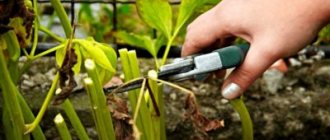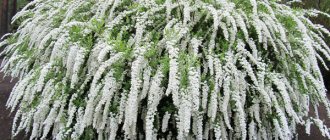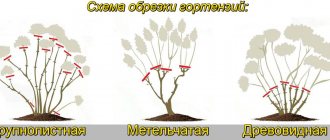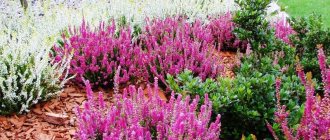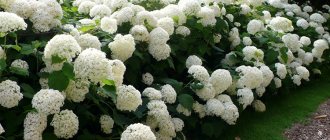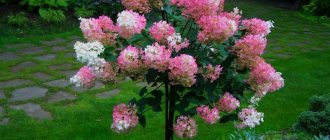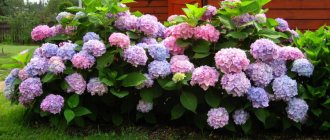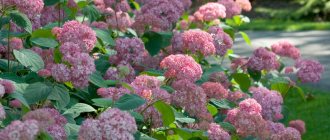Hydrangea is loved by gardeners for its stunning blooms. Also, by adding different fertilizers, you can get the desired shade of inflorescences.
Dear readers! For you, we have created communities on social networks in which useful articles and interesting ideas are published several times a day! Subscribe and receive useful content in a convenient format!
Hydrangea is a perennial, which means that every autumn the question arises about appropriate measures to prepare the shrub for winter.
In today's article we will find out what care the plant needs before the onset of cold weather.
When and how to prune hydrangeas in the fall
In general, the lower leaves from the bushes should be removed by the first days of August. This is done so that the trunk of the bush becomes as woody as possible.
The type of pruning depends on the variety of hydrangea. For example, tree and panicle hydrangeas can be pruned short.
But for large-leaved specimens, the tops are only slightly shortened. Sanitary pruning is also carried out.
Sanitary pruning involves the removal of dried inflorescences, damaged inflorescences, diseased, old and broken shoots. In the tree-like variety, healthy branches are cut into 4 buds.
During radical rejuvenation, “stumps” 20 cm high are left.
Pruning paniculate hydrangea involves removing diseased and weak branches and shoots that thicken the crown.
IMPORTANT! Pay special attention to pruning bush hydrangeas.
Varieties of paniculata, tree-like and large-leaved hydrangea - names and photos
And here are the lines the famous poet Andrei Podvolotsky dedicated to the flower: “Hydrangea bloomed in your garden, Such yellow-blue tenderness, Reminiscent of the Garden of Eden of Paradise...”
In fact, there is a lot of paradise in this flower: a fragrant aroma, beautiful buds. According to one version, the name of the flower comes from the Greek words hydor and angeion - a vessel with water, or Hydrangea. According to another, it is believed that the plant was named after a certain lady with a rare name. In any case, the Hydrangeaceae family is large, and we will look at several popular garden varieties.
Paniculata hydrangea is a variety of Bobo. This is a highly awarded dwarf bush in Belgium. Interestingly, the petals change color from creamy yellow to pinkish
Bobo is a great option for a container in a slightly shaded area. The wind does not favor this type.
Another great variety is Vanille Fraise.
The giant among paniculata hydrangeas, Vanilla Fraze, reaches 2 m, so this variety is chosen for large gardens. Pay attention to the impressive inflorescences, reaching 30 cm in diameter.
Grandiflora with pyramidal inflorescences will decorate a shady corner in the garden
Grandiflora 's color changes gradually from white, pink to greenish-red shades. Tree hydrangea is represented by numerous varieties of shrubs and even vines.
Annabelle spreads its crown with leaves that never turn yellow
Anabel grows up to 1.5 m, and the spreading crown occupies 3 m. The variety pleases with long flowering and large cream-colored inflorescences.
White Dome - a creamy white variety of Hydrangea paniculata
The strong bush does not allow the inflorescences to fall off in rainy weather. This is the most winter-hardy variety. Large-leaved hydrangea is the most delicate of all, but breeders have already developed a variety with increased winter hardiness - Endless Summer. Endless Summer's color changes vary in blue tones.
Endless Summer with ruffled petal edges
Green Shadows surprises with the reddish tint of the inflorescences. The variety got its name because of the green shadows along the edges of the petals.
Treatment of hydrangea in autumn
Hydrangea is not one of the most disease-prone garden crops. However, it should also be treated in the fall as part of sanitary measures in preparation for winter.
Spray hydrangea on bare branches. They also cultivate the soil under each bush.
Among the drugs against fungal, bacterial and viral infections, Bordeaux mixture (1%) or Abiga-Pik (40 ml per bucket of water) is used.
Aktara helps well against pests.
Petiole hydrangea in landscape design
Attractive appearance, abundant flowering and high growth rates make walking hydrangea a popular crop in landscape design .
It is used as a ground cover plant and as a bindweed for arbors. The vine is often planted as a hedge.
Petiole hydrangea is a very beautiful plant. Its dense foliage creates a dense cover both on the ground and on a wall or trellis.
Abundant flowering lasts all summer, and even an inexperienced gardener can cope with growing the crop.
Feeding hydrangeas in autumn
The moment of feeding perennials before winter is important. To strengthen the root system, as well as the ripening of shoots, potassium and phosphorus fertilizers are used.
Fertilizers are applied before pruning. It is recommended to use granular fertilizer. It is scattered in a circle around the trunk and then embedded in the soil. If the autumn is rainy, the fertilizer decomposes from the rain. If the weather is dry, then it is worth watering the bushes.
The consumption rate of the preparations is 15 g of potassium monophosphate and 15 g of superphosphate per 1 sq. meter of trunk circle, or 40 grams of each drug per bush.
IMPORTANT! In the fall, it is highly recommended not to apply organic fertilizers. It is also undesirable to use fertilizers high in boron, magnesium and iron.
It is permissible to use only wood ash from organic matter (2 cups for each bush).
A special feature of hydrangea is that you can change the color of the inflorescences by applying different fertilizers. Including in the fall.
For example, by mulching the surface with pine needles and acidic peat, you can give the inflorescences a blue and blue tint.
Reproduction
New plants are obtained from seeds and vegetative propagation methods .
Growing from seeds
This method is time-consuming and labor-intensive, but makes it possible to obtain a large number of seedlings.
- Seeds are sown in a container with nutrient soil.
- Cover with film or glass, opening daily for ventilation.
- Water with a spray bottle as needed and keep in a warm, well-lit place.
After about 50 days, shoots will appear. The appearance of cotyledon leaves will be a signal to pick seedlings.
Cuttings
The material is harvested in the spring before flowering begins . For pruning, choose young but strong shoots with two nodes. The length of the cutting can reach 15 cm. The top is shortened, and the lower cut is treated with a root formation stimulator. The cuttings are planted in a container filled with a mixture of sand and peat and covered with film.
Dividing the bush
This method is quite complicated, given the size of the vine . Smaller varieties are usually propagated this way because they can be dug up without damaging the plant.
The root ball is carefully removed from the ground, shaken off and cut into 2-3 parts. Each of them is nurtured as an independent plant.
By layering
A trench is dug next to the bush, where one of the lower shoots is bent, fixing it. The appearance of roots on the layering is a signal to the gardener that the new plant needs to be separated from the mother plant, finding a new cozy place for it.
When to stop watering hydrangeas before winter
Another important issue that needs to be addressed when preparing hydrangeas for winter is the frequency and abundance of watering.
Starting in September, the frequency of watering is reduced. And in rainy autumn they stop altogether. Moreover, if rainy weather persists for a long time, then the bushes are covered with film to prevent them from being flooded.
Over-watering in the fall is completely unnecessary.
If the autumn turns out to be dry, then watering must be completed by the end of the second decade of October, that is, by the time the leaves have completely fallen off the plant.
Watering regime in autumn
Hydrangea is a moisture-loving plant; water it regularly with plenty of water. However, this rule applies to the spring and summer seasons. In autumn, abundant watering of hydrangea is contraindicated. In September, the plant stops watering. An exception can be made if it is a warm and dry autumn. Under such conditions, the bush can be watered 1-2 times.
When to cover hydrangea for the winter in different regions
Depending on the climatic characteristics of the growing region. The warmer it is, the later you can start covering the bush.
- In the Middle Zone, construction of insulating structures begins at the end of October.
- In the Leningrad region and neighboring regions, preparations for winter are completed in mid-October.
- In the Urals and Siberia, all care activities must be completed by the end of September.
- In the southern regions, hydrangea does not need to be covered. But care must include pruning.
As for the specific date of the procedure, they are guided by the condition of the bush (fall of leaves) or the weather (temperature around zero).
Rules for spring unwrapping hydrangeas
Like other plants that require winter shelter, hydrangea also needs to be opened in stages. The main thing here is not to rush. You need to start unwrapping when the weather warms up. If we are talking about large-leaf hydrangea, then the top film should be removed for the day and returned to its place in the evening. The foliage with which the plant is covered can begin to dry in mid-spring. It is possible to completely remove all the insulation from the bush only at the moment when the first buds begin to appear on the hydrangea.
After removing the last layer of insulation, the shoots of the bush are immediately untied and straightened. Within a few days it levels out, after which spring pruning is carried out.
How to cover hydrangea before winter
For the winter, hydrangea is covered. This is especially important for residents of the coldest regions of our country.
There are several ways to carry out this procedure correctly. Let's take a closer look at them.
Leaves
Hydrangea shoots are carefully bent to the ground and fixed.
Next, they are covered with leaves and a thin layer of non-woven material is placed on top.
In winter you will need to add snow on top.
Coniferous spruce branches
The insulation algorithm is as follows:
- We lay spruce branches under the bush.
- We tilt the shoots and place them on the spruce branches. Don't forget to anchor it near the ground.
- Place another layer of spruce branches on top.
- We cover everything with non-woven material and put weights on top.
Air-dry shelter
First of all, we need to prepare both the hydrangea and the material for constructing the covering structure.
First, cover the bush with soil or peat. Next, bend the shoots to the ground and strengthen them.
Next, you need to install a frame around the bush. Non-woven material is stretched over the frame. Don't forget to make ventilation holes. They must be closed for the winter, but released again in the spring.
Cover the frame with fallen snow.
Shelter construction
When constructing a shelter, you need to take into account the variety of hydrangea, the size of the bush and its age. For an adult shrub, you can limit yourself to hilling; snow will play the role of additional insulation here. In young specimens it is still better to cover the shoots. Features of covering measures for each type of plant will be as follows:
- In paniculate hydrangea, the most viable buds are formed in the middle part of the shoots, so freezing of the tops of the branches will not cause much harm to the plant. When building a shelter for it, you need to take into account the weather conditions of the region. It’s not just frost that can play a negative role. In strong and humid winds, the bush can suffer much more severely. In the southern regions and the middle zone for paniculata hydrangea, a sufficiently high hilling with a mixture of dry soil and peat will be sufficient. In Siberia and the Urals, branches are bent into the ground and secured by throwing spruce branches, burlap or agrofibre on top. Large bushes are wrapped in a vertical position with several layers of non-woven covering material.
- For heat-loving large-leaved hydrangea, shelter must be made in advance, without waiting for sub-zero temperatures to arrive. Before covering the plant, the leaves are torn off, leaving them only at the very top to protect the apical buds. After this, the bush is divided in half, bending each part to the ground and installing metal arcs over the branches. Then the hydrangea is mulched with peat or pine needles. The top of the arc needs to be covered with two layers of lutrasil, securing it near the ground. Film should not be used for covering because it does not allow air to pass through. You can release the bush in the spring only after the frosts have disappeared.
- Tree hydrangea is a strong and unpretentious plant that requires minimal recovery time in the spring. With age, the winter hardiness of the crop increases, but for the purpose of prevention it is better to cover it. It is necessary to hill up the roots. The above-ground part is insulated in a vertical position, after tying the shoots to a peg. Spruce branches are laid on top around the plant. In the northern regions, the above-ground part is additionally covered with two or three layers of spunbond or lutrasil. You can secure the material to the plant using a rope. For large and old bushes, a frame shelter is built, filling it inside with dry foliage. In this case, the upper part of the structure will need to be protected from moisture penetration.
Proper shelter will allow the hydrangea to successfully overwinter, remaining strong and healthy. If there is insufficient insulation, the bush will not die, but you won’t have to expect abundant flowering from it. The tops of the shoots on which flower buds are formed are usually frozen. In the spring, the covering material should not be removed abruptly; at first, it is only slightly opened during the thaw. It is recommended to finally remove the shelter when the snow begins to actively melt.
Features of hydrangea shelter depending on the region
Now let's talk about some of the nuances of preparing hydrangeas for winter in different regions.
In Central Russia, it is necessary to cover large-leaved and oak-leaved varieties of the crop. It is enough to lightly mulch the ground cover.
In the south, hydrangeas may not need to be covered at all. You can only mulch the plants a little if you are afraid of a cold winter.
In Siberia and the Urals, it is advisable to cover all varieties of hydrangea. These regions have very harsh winters, so it is better to be on the safe side.
Tips from gardeners
After covering the hydrangea, it is necessary to monitor the ambient temperature. When there is a thaw, you need to open the insulation a little for ventilation. Excess moisture can cause damping off.
Hydrangea requires the most attention in spring. After opening, it is important to inspect and prune the bush correctly. If the shoots have been frozen, they will be dark brown in color. They can be removed after the first buds appear on the bush during sanitary pruning. You should not prune the shoots early, as the plant will lose a lot of sap.
Covering old hydrangeas in autumn
Different types of hydrangeas require different approaches. We have collected information on all varieties in one table for ease of perception.
Table. Sheltering hydrangeas for the winter depending on the variety
| Variety | Features of preparation for winter |
| Tree-like | Does not require shelter. Tolerates frosts well |
| Paniculata | Requires insulation only in the coldest regions. Tolerates frosty winters well |
| large-leaved | Requires careful insulation as it freezes easily |
| Ground cover | It is enough to lightly mulch with sawdust, peat or fallen leaves from trees. |
| Oakleaf | Needs to be well insulated for winter |
| Chereshkova | Does not require insulation |
ON A NOTE. Do not forget to hill up the rhizomes of the shrub. To do this, use dry soil, peat and leaves.
Typically, hydrangea branches are bent to the ground. But this is not always possible. If the shoots are too woody, they are pulled into a vertical cylinder. A frame is made around it, inside which foliage is poured. The top is covered with spruce branches and wrapped in agrofibre.
Autumn pruning rules
Not everyone believes that it is necessary to prune hydrangeas for the winter. Some gardeners believe that the bush can easily form on its own, while others prefer to prune it in the spring. However, experts insist on the need for autumn pruning of bushes. The bush is cleared of diseased, weak and damaged branches, and healthy shoots are shortened. This needs to be done, because in the spring not everyone has time to get to their garden plot early, when the hydrangea has not yet awakened from sleep.
The important point is that after the sap flow begins, pruning can no longer be done. It is better to set aside time for it in late autumn, and in the spring to remove branches damaged by frost. Most often in Russia, three types of hydrangea are grown: paniculate, large-leaved and tree-like. Each of them has its own pruning rules, taking into account the characteristics of the plant:
- Hydrangea paniculata is a large shrub up to 2.5 m high with a lush spherical crown. Pyramidal inflorescences change color from greenish to white, pink or purple during flowering. This type is not subjected to a radical haircut. Hydrangea is pruned moderately, forming a crown, thinning the bush and rejuvenating it. It is not recommended to touch skeletal branches. If several shoots appear at one point of growth at once, it is necessary to leave the strongest one and remove the rest. Weak and damaged branches also need to be removed. If the bush needs rejuvenation, this is done gradually, stretching the process over 2-3 seasons. Old shoots are cut out one by one, leaving stumps 10-15 cm high.
- Large-leaved hydrangea is more suitable for growing in southern climates. In terms of decorativeness, it is superior to other types. This hydrangea has very large inflorescences and spectacular foliage. For large-leaved hydrangea, preparation for winter is carried out more carefully, taking into account its low frost resistance. When pruning, you need to remember that flowers bloom on last year's shoots. If these branches are greatly shortened, the bush will not bloom next season. Shoots that are older than four years are cut out at the base. Autumn pruning of this type of hydrangea is done to clean and rejuvenate the bush. Fresh growth is allowed to overwinter, because it is on it that flower buds are formed. If young branches suffer from frost in winter, they can be pruned in the spring.
- Tree hydrangea is pruned in the same way as paniculate. For sanitary purposes, diseased, broken and dry shoots are removed, and the caps of inflorescences are cut off. You also need to cut out branches growing inside the crown, and zero shoots that did not bloom this year. Next season there will still be no flowers on these branches; they will only contribute to the thickening of the bush and take away its strength. Powerful skeletal branches are shortened by 2-3 buds. This species needs pruning more than others because it has a high growth rate.
Advice!
After pruning, the bush is treated with three percent Bordeaux mixture. Spraying will protect against various diseases and pest attacks. The remaining solution is poured into the tree trunk to disinfect the soil.
Common mistakes
- Hydrangea is not pruned. All varieties of hydrangea require pruning to one degree or another. This is an important part of autumn shrub care.
- Hydrangea does not hide. In the conditions of the Middle Zone and especially the Urals and Siberia, the crop must be insulated for the winter from frost.
- The plant remains without water in the fall. During half of autumn, hydrangea needs regular watering. You cannot leave the plant without water immediately after flowering.
- Incorrect feeding. Autumn care is feeding with potassium and phosphorus compounds. Nitrogen and most organic matter cannot be used.
- There is no treatment for diseases. Hydrangea and the soil under it must be sprayed with fungicides.
- Incorrect trimming. The degree of pruning depends on the type of shrub. Some require only careful pinching of the crown and sanitary thinning.
- There are no ventilation holes in the covering structure. In any case, it is necessary to ensure access of air to the shoots of the plant so that they do not begin to rot.
Selection of location and conditions of detention
The ideal place for planting is a quiet area near the house, surrounded by trees. Petiole hydrangea does not like open places, windy and very sunny areas with dry hot air.
Prefers acidic, loose, humus-rich soils with good drainage. At a young age, it requires regular watering. The first years after planting, even with good care, the vine grows slowly and does not bloom. Over time, it “picks up speed” and produces huge gains - up to 1 m per season.
It begins to bloom in the second, third year after planting or even later, it depends on the size of the plant, lighting and microclimate of the area. The first inflorescences appear on the lower shoots, so the plant at first resembles a “ballerina in a tutu.”
Hydrangea does not like transplants, so it must be planted immediately in a permanent place. But with good care, it can withstand any haircut, even trimming to a stump. After this, it does not die, but slowly grows back.
The liana has many aerial roots and suckers, through which it attaches to the support. But at the same time, she is not able to find support on her own; she needs to be shown where to crawl. Just don’t tie the shoots, you just need to put wooden slats under them, and she will choose which side to start climbing from. Over time, the vine will completely entwine a tree trunk or fence with its powerful shoots, literally “sticking” to the surface.
The best support for a climbing hydrangea in the garden is a durable tree with fairly hard wood. For example, ship pine, hundred-year-old oak, large larch or linden; as a last resort - a serious pillar or a powerful pergola, built to last. Birch, poplar, apple, bird cherry, crabapple or short-lived maple trees cannot serve as support.
You can allow the vine to weave the wall of a house, garage, barn, but certainly a brick or stone one. A wooden surface is not suitable because it needs to be painted from time to time, and it is simply impossible to tear an adult hydrangea away from its support.
There is another interesting option for growing petiole hydrangea - in the form of a small bush up to 2-3 m. To prevent its shoots from falling, they are secured with reinforcement, then the plant is cut annually. The result is something like a garden bonsai. Troublesome, of course, but original. Suitable for an oriental-style garden, especially since petiolate hydrangea is Japanese by nationality.
Sometimes petiole hydrangea is used as a ground cover plant. But in this case you will never see it in all its splendor; in addition, it will take up an incredibly large amount of space and is unlikely to bloom on the ground. The only reason for this method of cultivation is to decorate a steep slope. Just keep in mind: it is almost impossible to walk on such a carpet, especially after rain, since the slippery shoots will constantly get tangled under your feet.
Answers to frequently asked questions
Do I need to water hydrangeas in the fall?
Yes, this is an important element of care. But this must be done very moderately and only until mid-October. Then the bush, on the contrary, is protected from waterlogging.
What care does a flower need?
Pruning, mulching, hilling, treating against diseases and covering are the minimum when preparing this perennial for winter.
Is it possible to replant a bush before winter?
Yes. And also propagate and rejuvenate. The fact is that the seedlings will take root over the winter and begin to bloom in the new season.
In addition, pests and pathogenic microorganisms that can harm the young plant go into hibernation during the winter.
What is the best treatment for diseases?
The most effective will be the modern drug "Abiga-PIK".
How to insulate a perennial?
Use leaf litter, spruce branches, non-woven material. Low-growing bushes can be completely covered with sawdust.
Caring for hydrangeas and feeding them in the spring during the recovery period
In the spring, it is necessary to clear the soil of last year's leaves and regularly weed. Before mulching, the soil around the bush needs to be loosened and peat moss added.
The important question of how to feed hydrangea in the spring has a simple answer: choose a complete mineral complex fertilizer
In spring, nitrogen-containing fertilizing is applied to the hydrangea. It is necessary for the growth of green mass and shoots. A complete complex fertilizer is best suited and will help accumulate strength for flowering. There is no need to rush into cleaning the shelter, but it is also better not to delay it. The plant is opened gradually, hardening it and preventing burns. At the same time, the bush is ventilated. If you remove the cover immediately, then, in addition to burns, you can dry out the buds, which is dangerous for the bush. Even after removing the covering material, at first it is worth shading the hydrangea with spruce branches or non-woven material.
During a long dry spring, it is necessary to water the hydrangea. If there are return frosts in your region, then when the buds and new leaves freeze, the plant will slow down in growth and development, and accordingly, the flowering will not be so lush and memorable. That is why they are in no hurry to completely remove the shelter. If your favorite is a representative of large-leaved varieties, then as soon as the buds begin to bloom, the bush is raised to avoid deformation of the shoots.
A worthy garden decoration!
But what a hydrangea can be like through the eyes of artists and painters - an amazingly beautiful flower, don’t you think?
Beautiful hydrangea in painting
Hydrangea is a wonderful shrub that makes your heart beat faster with its fabulous beauty. Our autumn plant care tips will help you preserve this wonderful fairy and help it survive the winter. Now you know how best to prune hydrangeas in the fall, how to cover them and what to feed them in the spring. We hope that our material was useful to you.
Plant pests and diseases
The most common diseases are:
- Chlorosis. Develops due to iron deficiency. The leaves turn yellow, but the veins remain pale green. The plant is weakening. You can only help it with special fertilizers.
- Powdery mildew. This is a fungal disease, due to which yellowish spots appear on the leaves of hydrangea, then the outer side of the leaf becomes brown, with clear contours, and the inner side becomes purple. To get rid of the disease, it is necessary to use fungicidal drugs.
- White rot. It is caused by a fungus and immediately affects the roots, which is why the hydrangea can quickly die. The shoots turn black and a whitish coating appears. The drug Fitosporin will help correct the situation.
- Gray rot. The leaves and stems of the plant become watery, then black spots form on them. Fundazol or Pure Flower will save you from illness.
- Ring spot. This is a viral disease that manifests itself as necrotic spots on the leaves. There is no way to cure the plant - all that remains is to burn it.
Among the insects that are dangerous for petiole hydrangea:
- aphid;
- root-knot nematodes;
- spider mite
Insecticidal and acaricidal preparations will help cope with the scourge. If a lot of snails appear on the vine, you will have to remove them manually. True, not so long ago special preparations appeared - molluscicides, which are produced in granules; they should be scattered over the entire surface of the soil around the plant.

